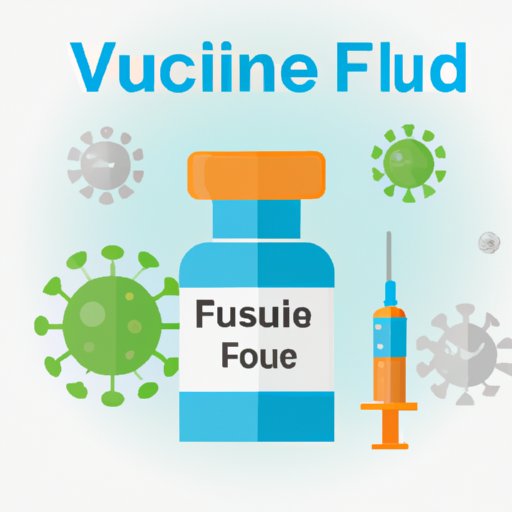Introduction
The flu vaccine is one of the most common and effective ways to protect against the flu virus. It is given as an injection or nasal spray, and can help reduce the risk of getting sick with the flu or spreading it to others. But how does the flu vaccine work? In this article, we explore the science behind the flu vaccine and provide a comprehensive guide to understanding how it works and why it’s so important to get vaccinated.
Exploring the Science Behind the Flu Vaccine
Before we dive into the specifics of how the flu vaccine works, it’s important to understand how the virus works. The influenza virus is a highly contagious respiratory virus that is spread through droplets in the air when someone coughs, sneezes, or talks. It is easily spread from person to person and can cause fever, chills, body aches, and other symptoms.
So how does the flu vaccine work to protect against the virus? The vaccine contains an inactive version of the virus that stimulates the body’s immune system to create antibodies. These antibodies are specific to the type of virus in the vaccine and help the body recognize and fight off the virus if it encounters it later on.

A Comprehensive Guide to How the Flu Vaccine Works
Now that we understand the basics of how the virus works and how the vaccine works, let’s take a deeper look at how the flu vaccine works. The following is a comprehensive guide to understanding how the flu vaccine works and why it’s so important to get vaccinated.
Explaining the Components of the Vaccine
The flu vaccine contains three main components: an antigen, an adjuvant, and an excipient. The antigen is the part of the vaccine that triggers the body’s immune system to create antibodies. This is usually a weakened or killed version of the virus. The adjuvant is a substance that helps boost the body’s immune response to the antigen. Finally, the excipient is a substance that helps stabilize the vaccine and make it easier to administer.
Explaining How the Vaccine Triggers an Immune Response
Once the vaccine is injected, the body recognizes the antigen as foreign and begins to produce antibodies in response. The antibodies bind to the antigen and mark it for destruction by the body’s immune system. If the body encounters the same virus later on, the antibodies will recognize it and attack it before it can cause infection or illness.

What You Need to Know About the Flu Vaccine and Its Mechanism of Action
There are several different types of flu vaccines available, each with its own mechanism of action. Inactivated vaccines contain dead viruses that stimulate the body’s immune system to create antibodies. Live attenuated vaccines contain weakened versions of the virus that can still replicate but not cause disease. Recombinant vaccines use pieces of the virus that have been genetically engineered to be safer and more effective.
The effectiveness of each type of vaccine varies depending on the strain of the virus and the age and health of the person receiving the vaccine. According to the Centers for Disease Control and Prevention (CDC), inactivated vaccines are typically 70-90% effective in preventing the flu, while live attenuated vaccines can be up to 95% effective.
Examining the Different Types of Flu Vaccines and Their Effectiveness
It’s important to note that the flu vaccine is not 100% effective. However, it can reduce the risk of getting sick with the flu and reduce the severity of symptoms if you do get sick. The CDC recommends that everyone 6 months and older get a flu shot every year to protect themselves and those around them. The best time to get the flu vaccine is in October or November, before the start of the flu season.
The CDC also recommends that people who are at high risk of serious complications from the flu – such as pregnant women, young children, and people with underlying health conditions – receive a higher-dose or adjuvanted vaccine, which has been shown to be more effective than standard-dose vaccines.

Understanding How the Flu Vaccine Prevents Infection and Illness
The flu vaccine is designed to prevent infection and illness caused by the influenza virus. When a person is vaccinated, their body produces antibodies that recognize the virus and attack it if they come into contact with it. This prevents the virus from entering the body and causing infection or illness.
The flu vaccine is the best way to protect yourself and your family from the flu. It is recommended for everyone 6 months and older and should be given every year. It is also important to practice good hygiene and social distancing to help prevent the spread of the virus.
Conclusion
The flu vaccine is an important tool for protecting against the flu and reducing the spread of the virus. By understanding how the vaccine works and the different types of vaccines available, you can make an informed decision about which one is right for you. Remember, the best way to protect yourself and your family is to get vaccinated every year.
(Note: Is this article not meeting your expectations? Do you have knowledge or insights to share? Unlock new opportunities and expand your reach by joining our authors team. Click Registration to join us and share your expertise with our readers.)
